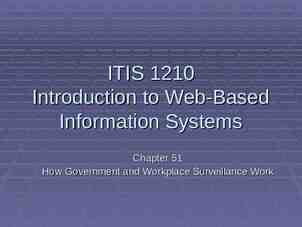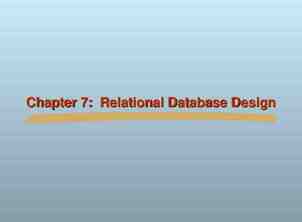USAF Civil Engineering Expeditionary Engineering Troop
25 Slides974.00 KB

USAF Civil Engineering Expeditionary Engineering Troop Leading Procedures

Overview THE TROOP LEADING PROCEDURES ARE THE DYNAMIC PROCESSES BY WHICH A LEADER RECEIVES, PLANS AND EXECUTES A MISSION: 1. RECEIVE MISSION 2. ISSUE WARNING ORDER 3. MAKE A TENTATIVE PLAN 4. INITIATE MOVEMENT 5. CONDUCT RECON 6. COMPLETE THE PLAN 7. ISSUE OPORD 8. SUPERVISE, REFINE, REHEARSE The order of steps 1-3 do not change Steps 4-7 are interchangeable. Step 8 occurs throughout the process. Expeditionary Engineering 2

Overview EIGHT STEPS Expeditionary Engineering 3

TLP - STEP 1 RECEIVE THE MISSION Conduct an initial *METT-TC analysis (* METT-TC to be explained) Determine the time available from mission receipt to execution Determine the useable time available to both you and your subordinates. Identify Critical Times such as: Start Point (SP) Rehearsals Reconnaissance Initiate Movement Anticipated Enemy Actions Quick Map Reconnaissance Backwards Planning Expeditionary Engineering 4

TLP – STEP 2 ISSUE THE WARNO Provides advanced notice to your unit of upcoming operation Provides as much information as possible to allow subordinates to begin parallel planning and preparation Does not sacrifice time to gain more information Issued to subordinate and supporting units Use five-paragraph format (ref: FM 101-5 and example in student handout) Situation (General, Enemy, Friendly, Weather, Light Data) Mission Statement (Who, What, When, Where, Why) Execution (Commander’s Intent, Key Tasks, End State, Concept of Operations, Tasks to Subordinate Units, and Coordinating Instructions) Service and Support (aka. Logisitics and Administration) Command and Control (aka. Command and Signal) Expeditionary Engineering 5

TLP – STEP 3 MAKE A TENTATIVE PLAN Develop estimate of the situation Detailed mission / situation analysis Course of action development Analysis of each course of action Comparison of each course of action Decision (tentative plan) The leader updates the estimate continuously and refines the plan accordingly. Expeditionary Engineering 6

TLP – STEP 3 MAKE A TENTATIVE PLAN – METT-TC Mission. As given by the commander. Analyzes commander's intent two command levels higher. Determines essential tasks the unit must perform in order to accomplish the mission. Enemy. Type, size, organization, tactics, and equipment of the enemy expected to be encountered. Identifies greatest threat to the mission. Identifies greatest vulnerability to enemy. Terrain. The leader considers the effect of terrain and weather on enemy and friendly forces using OCOKA: Observation and fields of fire Cover and concealment Obstacles Key terrain Avenues of approach Expeditionary Engineering 7

TLP – STEP 3 MAKE A TENTATIVE PLAN – METT-TC Troops available. Consider strength of subordinate units, characteristics of weapon systems, and capabilities of attached elements as tasks are assigned to subordinate units. Time available. Refine allocation of time based on tentative plan and any changes to the situation. Civilian Considerations. Consider displaced civilians that may be encountered during operations. Leader must determine actions to take if civilians are on the battlefield. Expeditionary Engineering 8

TLP – STEP 4 INITIATE MOVEMENT May occur at any point in the Troop Leading Process Includes movement to positions closer to LD, initial inspections, reconnaissance, battle drill rehearsals or SOP items If the reconnaissance reveals a change in the situation, the plan must be adjusted accordingly The steps do not have to be accomplished in order Expeditionary Engineering 9

TLP – STEP 5 RECONNITER Reconnaissance is used to confirm terrain and/or enemy analysis and tactical options Situation and time available dictate the type and detail of reconnaissance Map, terrain model, aerial photo, ground Plan and conduct a leader’s reconnaissance for every mission Consider risk inherent in moving forward of friendly lines, or into unoccupied area Expeditionary Engineering 10

TLP – STEP 6 COMPLETE THE PLAN Develop OPORD Tentative plan Reconnaissance Additional guidance Review plan Satisfy Commander’s mission and intent Alter tentative plan if needed Reconnaissance Changes to current situation Use 5-paragraph format used in WARNO Content is key factor – KISS principle OPORD provides all details – expands on WARNO – necessary for to complete mission IAW CC intent Expeditionary Engineering 11

FRAGO 5 Paragraph Example Expeditionary Engineering 12

FRAGO 5 Paragraph Example Cont. Expeditionary Engineering 13

TLP – STEP 7 ISSUE OPERATIONS ORDER (OPORD) Issue face to face if physically possible Usually done as a briefing Can be in written format for larger units (Squadron and above sized units) Issue while observing the combat area if possible Supplements to OPORDs Terrain models Sand Table Map boards/Overlays Sketches Fire Support Matrix All subordinates must understand the plan Use briefbacks Expeditionary Engineering 14

TLP – STEP 8 SUPERVISE PLANNING AND PREPARATIONS Confirmation Briefs Check Inspect Rehearse Coordinate Refine Expeditionary Engineering 15

TLP – STEP 8 SUPERVISE PLANNING AND PREPARATIONS Must be habitual during training in order to effectively employ units tactically Clarifies Commander’s intent Reinforces scheme of maneuver Ensures understanding and instills confidence in participants Provides feedback and exposes problems in the plan Expeditionary Engineering 16

TLP – STEP 8 SUPERVISE PLANNING AND PREPARATIONS Pre-Combat Inspections (PCIs) Weapons and ammo: test fire Uniforms and equipment Mission Essential Equipment Troops understanding of mission and their specific responsibilities Communications: radios, frequencies, batteries Rations and water Camouflage; personnel and equipment Expeditionary Engineering 17

Summary 1. RECEIVE MISSION 2. ISSUE WARNING ORDER 3. MAKE A TENTATIVE PLAN 4. INITIATE MOVEMENT 5. CONDUCT RECON 6. COMPLETE THE PLAN 7. ISSUE OPORD 8. SUPERVISE, REFINE, REHEARSE Expeditionary Engineering 18

“In preparing for battle I have always found that plans are useless, but planning is indispensable.” -- Gen Dwight D. Eisenhower Questions? Expeditionary Engineering 19

USAF Civil Engineering Expeditionary Engineering Convoy Operations What, Why, Whom, & When Trained

What is a CONVOY and why is it needed? A group of vehicles organized for the purpose of control and orderly movement with or without escort protection that moves over the same route at the same time and under one commander The purpose of a convoy is a logistical movement of assets from one point to another. This is a preferred method of movement when accountability, protection, and/or timeliness must be maintained Expeditionary Engineering 21

Convoys and the AF In the current Afghanistan AOR, the AF does not own any convoys with the exception of specialized units. AF personnel may be part of Convoys that are under the control of the ARMY or other service. If AF personnel are to be used in Convoy they should receive training from venues such as Power Projection Platforms (PPP) or with in the AOR. As leaders we must ensure we do not expose troops to dangers they are not trained for. Expeditionary Engineering 22

Considerations for any Convoy Route/Accessibility/Timing/Fuel/Hazards Convoy Speeds dictated by: Vehicles, driver’s ability, weather, road conditions, law Vehicle Recovery Always consider road conditions and restrictions, fuel consumption, time required to traverse Know how to recover and requirements for abandoning Communications Convoy CC, Vehicle CC, Driver, CC Centers, sectors of response/support Expeditionary Engineering 23

Considerations for Convoy under Combat Conditions Still have same consideration as you would in Non-combat but with the addition of: Enemy threat Defense Call in support and/or report threats, breaking contact Communications Weapon systems, Armor, Safe havens, Cleared routes CAS, QRF, Sector support, INTEL IEDs, VIEDs, IDF, DF, local population, ROEs, Convoy CC, Vehicle CC, Driver, CC Centers, sectors of response/support YOU MUST BE TRAINED FOR COMBAT CONVOY Expeditionary Engineering 24

Summary What is a convoy and why is it done AF does not own convoys in AOR Personnel must be trained prior to convoying (PPP) Considerations for convoying Considerations for convoying under Combat conditions Expeditionary Engineering 25






